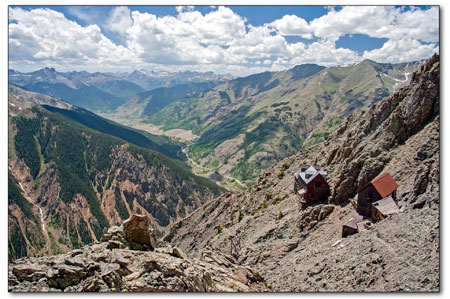
The Old Hundred Boarding House and adjacent tram house is seen high on Galena Mountain, with Silverton in the distance. The 11-year-old structure is in dire need of repairs after it was discovered marmots had been feasting on the floor boards and ice was forming a wedge between the building and the adjoining mountainside./Photo courtesy Ray Dileo, San Juan County Historical Society
Castle keepers
Historical Society seeks funds to restore iconic ‘Castle in the Sky’
by Missy Votel
A move is afoot in Silverton to save the iconic Old Hundred Boarding House not just from gravitational forces, but varmints.
Built in 1904, the vestige of the San Juan Mountains mining heyday sits at 13,278-feet on Galena Mountain, about 4 miles northeast of Silverton. Despite its relative longevity, it was found to be infested with “some healthy and ravenous” marmots during a site visit last summer by a contingent of San Juan County Historical Society members.
“They actually seem to subsist on the boarding house floors,” stated a news release from the Historical Society.
| To donate to the Old Hundred project: - Send a check to: San Juan County Historical Society, P.O. Box 154, Silverton, CO 81433. - For more information, go to: sanjuancountyhistoricalsociety.org |
In addition, the structure was found to be “peeling away” from the mountainside, due to the freeze-thaw cycle of water between the rock face and the building.
“Ice gets between the building and the rock wall and it just presses that building,” Bev Rich, chairwoman of the Historical Society, said.
To save the boarding house, which is a state historic landmark, the structure will need to be fastened to the rock face with steel. In addition, new windows and floors will need to be installed, to keep the building up and the rodents out.
But the restoration work will not come cheap. Preliminary estimates pin the cost at $30,000 or more – that’s if a helicopter can be donated to reach the precarious site.
As a result, the Historical Society has launched a campaign to raise 25 percent of that (about $7,500) to cover matching funds for grants. So far, it has gotten a donation of $500 toward that effort.
The Historical Society faced a similar situation in 1998-99, when it raised funds to repair the boarding house’s caved-in roof and fix the adjacent tram house.
“Now that we’ve spent all that money on it before, we’d hate to see it tumble to the bottom of the canyon now,” Rich said.
Of course, what crews will face today is nothing compared to what crews faced when construction began on the boarding house at the turn of the last century.
“When weather permitted, construction crews led mule teams burdened with building materials 6½ miles up a trail of repeating switchbacks to Galena Mountain’s 13,278-foot summit,” according to a 2001 article by Ben Fogelberg, in Colorado History NOW. “Workers hand-winched the materials down a wooden chute to the Old Hundred Mine’s Level 7 adit. There, 2,000 feet above the valley floor on the mountain’s pitched eastern face, they carved two slim ledges on which they built the mine’s boarding house and tramway terminal.”
The boarding house accommodated 24 miners during their off-hours from the Old Hundred Gold Mine. Discovered by German immigrants, the Neigold brothers, in 1898, the vein and ensuing mine was later bought by the Old Hundred Mining Co. in 1904. The company raised nearly $1 million to build a tramway to transport ore from the mine’s mouth, down to the mill and narrow gauge railroad in the valley below. A narrow boardwalk connected the boarding house and the nearby tram terminal building.
By 1906, gold bars were being shipped to the Denver Mint, but by 1908, the good gold was “mined out” and the mine shut down. The Old Hundred Mining Co., which reportedly never made a profit, later defaulted on its debt and the property reverted back to the Neigolds. Eventually, it was lost to back taxes and the mine changed hands a few times over the decades that followed, according to the Old Hundred Mine Tour website. However, the dreams of striking it rich at the Old Hundred never materialized. Today, the only remnants of that dream are the abandoned boardinghouse and miles of empty tunnels, which tourists can now visit via a guided tour.
Thanks to Mark Esper, of the Silverton Standard, for supplying the meat and bones for this story.
